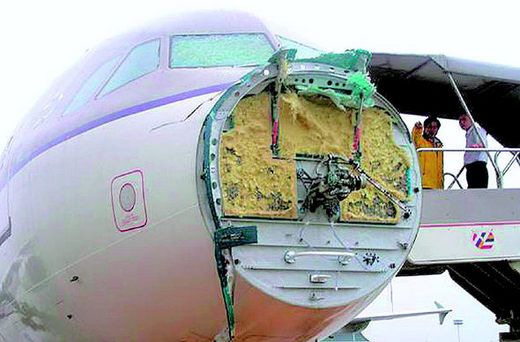 |
Airline’s report raises question of cover-up
The main cause of the June 9 emergency landing of Asiana Airlines flight 8942, which was pelted with hailstones and struck by lightning, appears to be pilot error. The hail and lightning caused the plane’s nose cone to shear off and its windshield to shatter, dangerously impairing pilot visibility. The plane landed with no injuries to its 200 passengers and crew.
According to documents obtained yesterday by the Hankyoreh from Asiana Airlines and the Korea Metrological Administration, the plane’s pilots ignored prior warning about the storm front and did not follow protocol in the situation. Additionally, discrepancies in Asiana’s version of events, as well as lauding the pilots involved without disclosing the reasons for the incident, raise questions of an attempted cover-up on the part of the airline.
According to the documents, Asiana Airlines flight 8942 was hit by hailstones at 5:40 p.m. on June 9 in the air above the southern Gyeonggi provincial region of Iljook. Previously, Asiana Airlines said the accident occurred at 5:45 p.m. in the sky over the region of Osan. At the time of the incident, the plane was traveling at speeds of up to 320 knots (about 593 kilometers per hour). The aircraft’s general speed is only 250 to 270 knots, raising concern as to the pilots’ decision to increase the plane’s speed during obviously inclement weather conditions. Civil airplanes are required to fly more than 10 to 20 miles away from cumulonimbus storm clouds. Prior to the accident, while flying to Seoul from the southern island of Jeju, flight 8942 turned north, following its scheduled flight path, even after confirming lines of towering cumulonimbus storm clouds in its path. The plane was turned directly in line with the clouds, and did not keep the required safe distance. Asiana Airlines said the plane’s radar system represents the cumulonimbus storm clouds as three colors: red, yellow and green, in descending order of strength. At the time of the incident, the plane was avoiding red and yellow storm clouds, but was flying through green clouds, Asian Airlines said. “Under such meteorological circumstances, no plane can avoid the entire cloud,” the airline said, suggesting the plane was being hit with the red and yellow force clouds, as well. In addition, Asiana Airlines said that the plane couldn’t change its route because it was nearing a landing site and its neighboring areas are designated as non-flight regions. Pilots asked about the situation disagreed, saying a change in flight route is possible if it is due to worsening climatic conditions.





